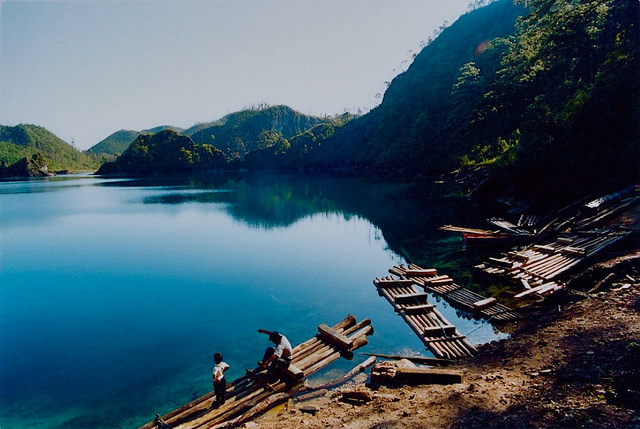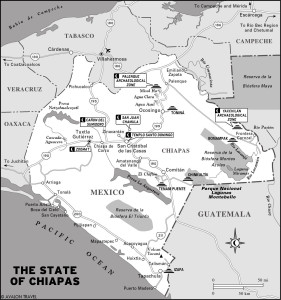
Lago Pojoj in Lagunas de Montebello National Park. Photo © Roberto Llebig, licensed Creative Commons Attribution.

The State of Chiapas
About an hour’s drive east of Comitán is Lagunas de Montebello national park (8 a.m.–sunset daily, US$1.75 pp), a striking array of lakes, lagoons, and ponds whose colors famously range from emerald green to pale blue, from deep purple to reddish black. The nearly 60 lakes are nestled in a cool pine forest, and around 15 are accessible and easy to reach by car or foot; a visit here typically includes driving from lake to lake, stopping at some for just a quick look and photo, and at others to swim or explore by canoe or kayak, available for rent along the shore. There are caves and even cenotes that can be visited, as well, either on foot or horseback.The Lagunas de Colores group of lakes is straight ahead as you pass through the control booth. There are five in all, including Laguna de Encantada, Laguna Ensueño, Laguna Esmeralda, Laguna Agua Tinta, and Laguna Bosque Azul, their colors ranging from emerald to indigo. The road dead-ends in a parking area overlooking Laguna Bosque Azul, the largest and most accessible lake, where there are simple open-air eateries plus cabins where you can rent boats to explore the lake.
From the far end of the parking area, a mild 1.5-kilometer (1-mile) trail leads mostly downhill to Grutas San Rafael del Arco, several limestone caves and an intriguing natural archway with a river running through it. It’s fairly well signed, though you might pay one of the local kids a dollar or two to be sure you see everything.
Horseback riding (US$5–8 per hour) is available from the parking area, too. The grutas are a popular destination, but not recommended as it’s perfectly easy to walk there yourself. A better option is riding to Dos Cenotes (twin limestone sinkholes), a trip of about 90 minutes. Bearing right after the control booth, the road leads past turnoffs for several more lakes. The first is Laguna Montebello, a large beautiful lake at the end of a 250-meter dirt access road. This is a good lake for swimming and horseback riding, including to Dos Cenotes. There’s a US$0.50 admission fee, which is good for admission to the rest of the lakes along this road as well.
Down the main road, the next turnoff after Laguna Montebello is for Cinco Lagunas, or Five Lakes (not to be confused with the five Lagunas de Colores). All but one are visible from the road; the second, Laguna La Cañada, is the most impressive, an hourglass-shaped lake that’s considered to be one of the park’s most picturesque. It’s an especially good place to paddle a kayak, available for rent (US$10 pp) near the roadway.
Yet another turnoff leads to Lago Pojoj, with a vibrant blue hue and an island in the middle that can be reached by kayak.
Lago Tziscao, the largest of Montebello’s lakes, is an expansive elbow of water with an observation point at one end and a somewhat dreary village built up nearby. Two hotels—one not bad, the other not so good—are right along the shore, where at least the views are attractive. Kayaks can be rented at both hotels. The better of the two hotels also offers boat tours (US$30, up to four people, Playa Escondida, tel. 963/634-9238), typically lasting around three hours including stops at a few small islands and a little-visited Maya ruin. Admission to the lake is US$0.50, charged right as you enter the village, and is also good for the other lakes along the main road.
There are simple accommodations along Lago Tziscao and Lagunas de Colores. There’s not much atmosphere, but staying here does allow you to enjoy the lakes in the early morning and at dusk, free of day trippers from Comitán and San Cristóbal.
Right on Lago Tziscao, Restaurant y Cabañas Playa Escondida (tel. 963/634-9238, US$2.50 pp camping, US$6.75 pp room with shared bathroom, US$8.50 pp room with private bathroom) is by far the best place to stay in town. Renovated in 2007—and in some cases, constructed—most accommodations are in A-frame cabins that have gorgeous views of the lake. Rooms are clean, if spare, and have hot-water bathrooms and 24-hour electricity. The grounds are well tended, inviting guests to lounge about, with a rowboat or two at the ready (and free) for guests to explore the lake. There also is a decent restaurant (6 a.m.–9 p.m., US$2–5) on-site, serving classic Mexican meals, so no worries about finding good, affordable eats. Boat tours of the lake can be arranged.
A short distance further, Hotel Tziscao (tel. 963/633-5244, US$35 up to four people) has spectacularly bad service but the cabins are reasonably comfortable, making it an acceptable alternative if Playa Escondida is full. Tiny A-frame wood cabins have two queen beds and a plain bathroom; the little porch in front would be a lot nicer if the huge cinderblock restaurant weren’t plunked down right in front, blocking the view. (Somehow it’s not surprising though.)
A kilometer (0.6 mile) from the Lagunas de Colores parking lot, Cabañas Bosque Azul (aka Cabañas de Doña Josefa, tel. 963/632- 5971, US$20 s/d with shared bathroom, US$29–37.50 s/d) has 20 wood-plank cabins, most with lofts and private bathrooms (hot water until 8 p.m. only). Beds are on the saggy side, and the bare bulbs and cement floors don’t help the matter, but the rooms are reasonably clean and the lake is just steps away. Pedal boats are available for guests to rent (US$12.50/hr).
The lakes’ best grub is at a cluster of open-air eateries (8 a.m.–sunset daily, US$1.25–3) facing the Lagunas de Colores parking lot, each with a handful of plastic tables set up under a low shelter. Service varies from friendly to rough-and-tumble, but the offerings are virtually identical—empanadas and quesadillas with bean, squash flower, and other fillings—prepared on a comal (griddle) over an open flame.
A vehicle is all but essential for visiting the lakes. Most people come in a van as part of a package tour, but you can also hire a taxi or combi in Comitán, or hire a truck and driver in the park itself.
If you’re driving a rental or private car, consider hiring one of the freelance guides who stand along the highway as you approach the national park (they can also be hired at Lagunas de Colores). Guides come along in your car, directing you to the various lakes and lookout points, and indicating which are best for swimming, kayaking, horseback riding, etc. There’s no fixed fee or route, but US$8–10 for a 2–2.5 tour seems average.
From Comitán, public transportation to the Lagunas de Montebello is provided by Lineas de Pasajeros Comitán–Lagos de Montebello (2a Av. Sur Pte. near 2a Calle Sur Pte., tel. 963/632-0875, every 10 mins 3 a.m.–6 p.m., 45–60 mins, US$2.50). Combis are required to take passengers to the Lagunas de Colores parking lot, not just drop them at the control booth; you can pick them up at the same place to return. The same company offers private tours by combi (US$67, 6 hrs), stopping at nine different lakes. If you want to tag on a visit to the Chincultik ruins, the tour costs an additional US$17. Prices are per van.
Once at the Lagunas de Colores parking lot, you can hire a truck and driver (US$35 per day) to take you to the lakes; if you hire a freelance guide, they can help arrange the truck. A one-way cab ride from Comitán to the Lagunas costs around US$20, while a six-hour tour, including stops at nine lakes, costs around US$75 per carload.
Excerpted from the First Edition of Moon Chiapas.